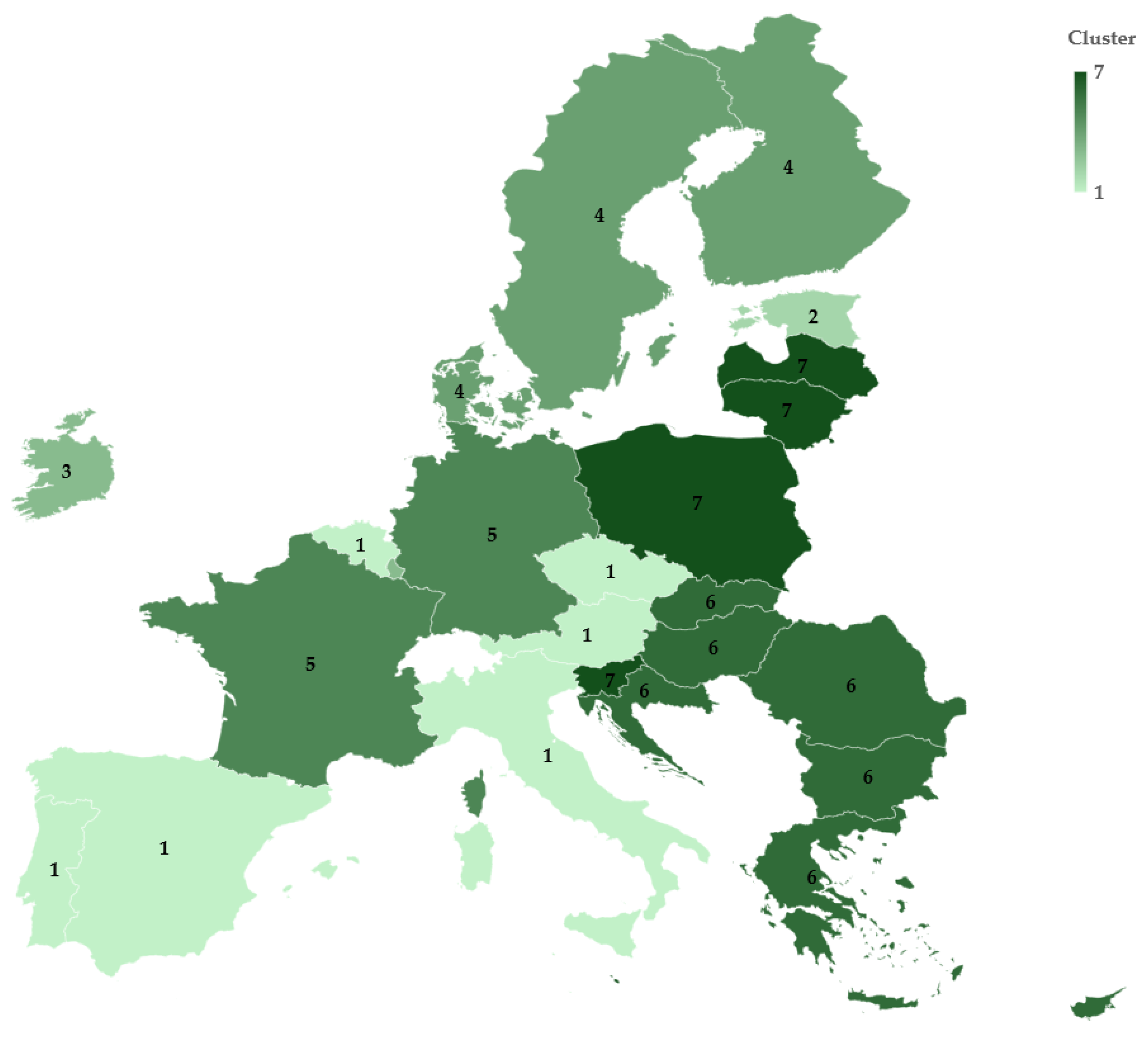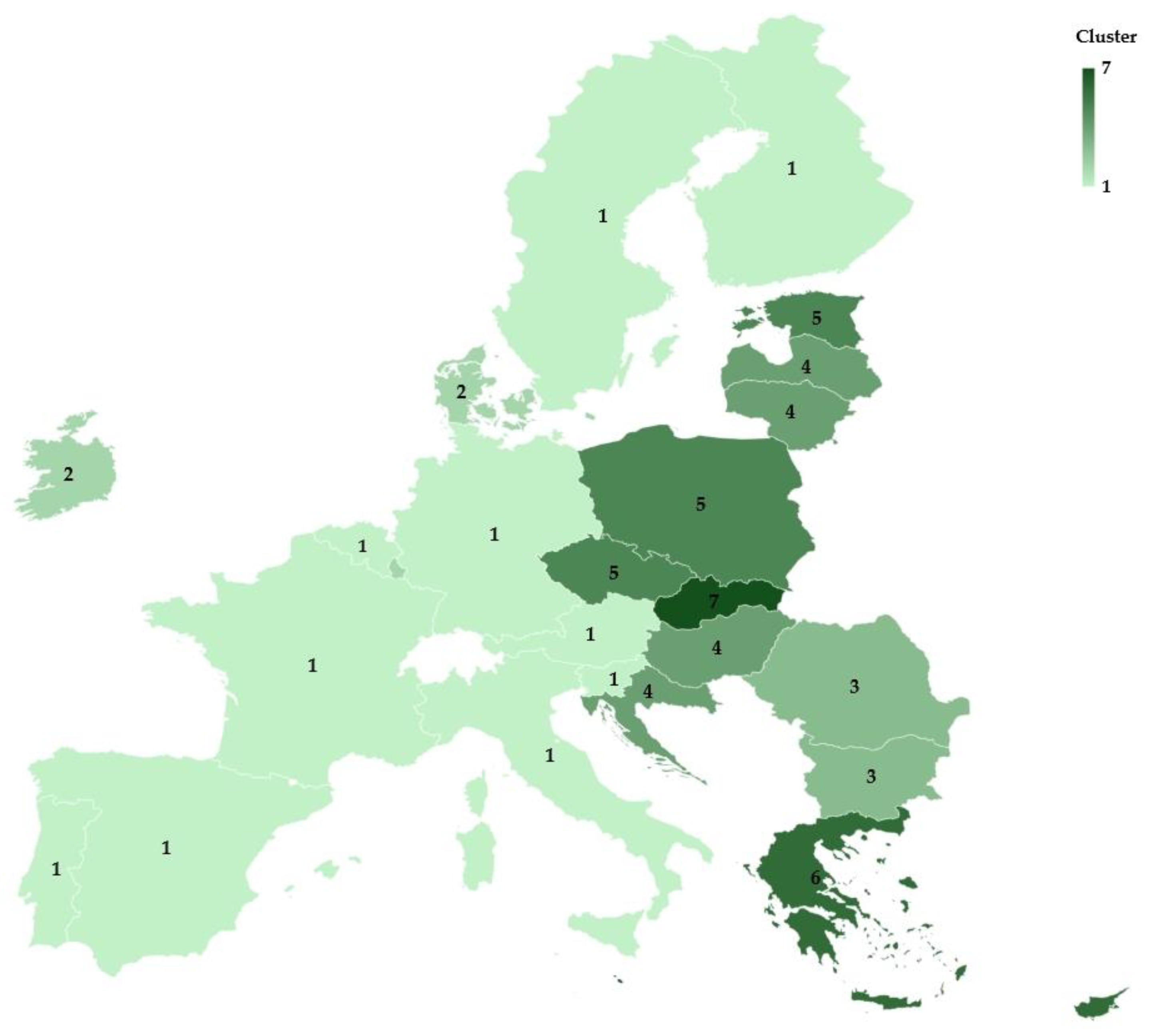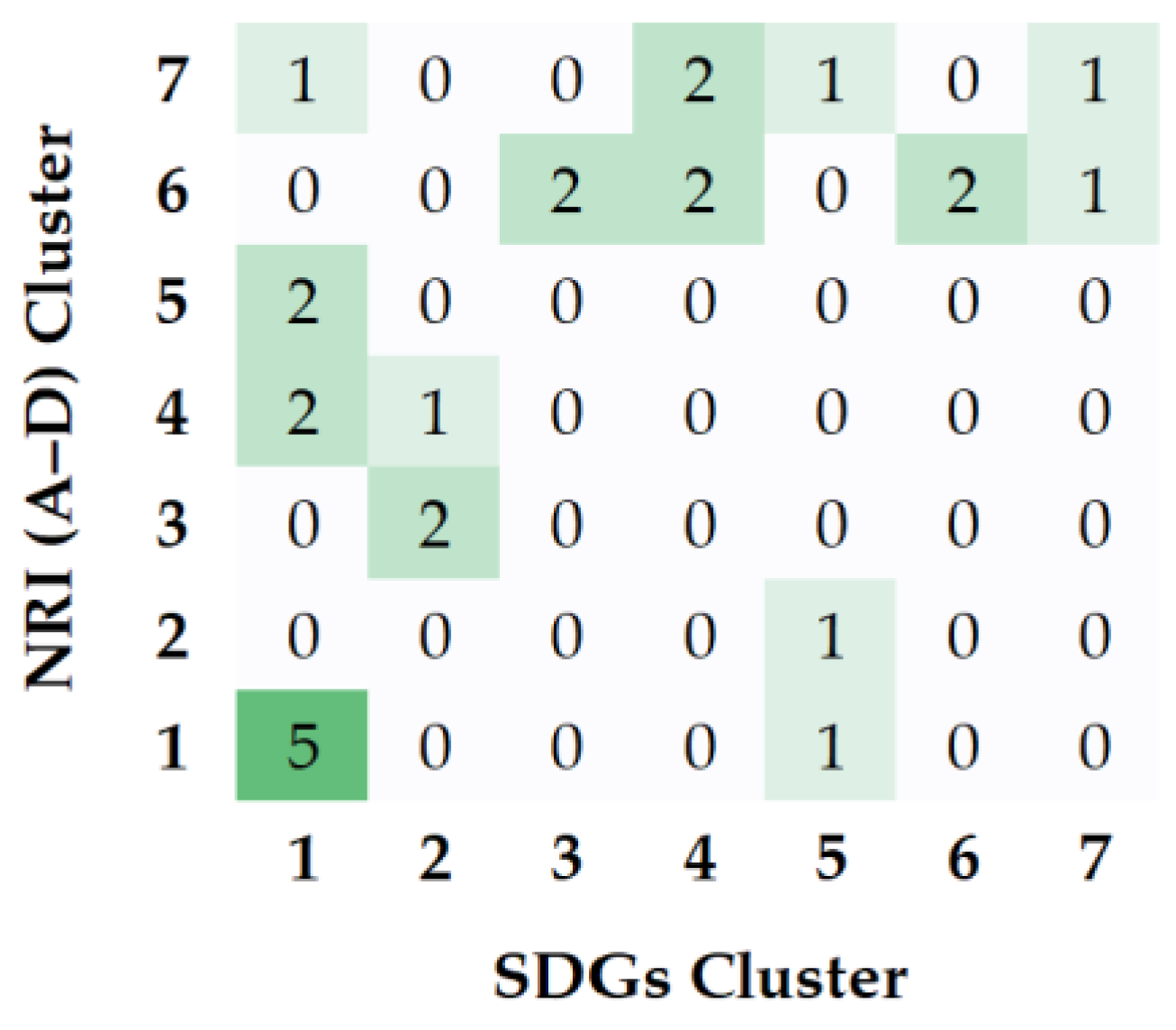Following the correlation analysis—which identified statistically significant relationships between the pillars of digital readiness (NRI) and selected SDGs—a hierarchical cluster analysis was conducted. The objective was to group countries into homogeneous clusters based on two dimensions: (1) their digital profiles (Pillars A–D of the NRI) and (2) their performance in relation to selected SDGs (SDG 3, SDG 4, SDG 5, SDG 7, and SDG 11).
This clustering approach offers a deeper understanding of regional patterns, highlighting similarities and differences among EU countries in terms of both digital maturity and sustainability performance. It also provides a valuable framework for identifying digital and sustainability “leaders” and “laggards” across the region. Moreover, the results serve as a practical foundation for designing targeted policies that address the specific development needs of different country groups—helping to align digital transformation with the SDG agenda more effectively.
The next section presents the results of two separate clustering procedures: one based on the four NRI pillars and the other on the selected SDG indicators. The results are interpreted based on the dendrogram outputs and the distribution of countries across the clusters.
4.2.1. Cluster Analysis Considering Pillars of NRI
We first focused on the four main pillars of the NRI: Technology, People, Governance, and Impact. To determine the optimal number of clusters in the hierarchical cluster analysis, we used the Duda–Hart index in combination with the pseudo-
T² value. This method identifies the most meaningful cluster distribution based on changes in the Duda–Hart index (
Je(2)/
Je(1)), where a higher index value and a simultaneously lower pseudo-
T² value indicate the optimal number of clusters.
Table 2 shows that the most significant breakpoint occurred when dividing countries into seven clusters, which was subsequently used for further analysis and interpretation.
A dendrogram was generated based on the cluster analysis (
Figure 3) to visually represent similarities among EU countries across the four pillars of the NRI (Technology, People, Governance, Impact). This hierarchical tree diagram groups countries according to their standardized scores on these pillars, using Ward’s method to minimize within-cluster variance and Euclidean distance as the dissimilarity metric. In the dendrogram, countries connected at lower levels of the hierarchy exhibit greater similarity in their digital development, while those joined higher up are more distinct. The optimal number of clusters—determined to be seven—was identified using the Duda–Hart index and pseudo-
T2 statistics, and is indicated by the main horizontal cut in the dendrogram. Each resulting cluster was then analyzed based on the average NRI scores for its member countries, reflecting their digital performance in 2024. Vertical line lengths in the dendrogram illustrate the degree of difference between clusters, and labeled boxes were added to enhance the clarity of country groupings.
To complement the dendrogram, a cartogram (
Figure 4) was created to visualize the geographic distribution of digital readiness clusters. This map-based visualization illustrates how countries are grouped spatially, revealing regional patterns and potential commonalities in digital development. The use of color-coding for clusters enables quick identification of regional concentrations of digitally advanced or lagging countries. While the dendrogram highlights structural similarities, the cartogram emphasizes the spatial dimension, offering insight into how digital readiness aligns—or diverges—from regional or continental boundaries.
To better understand the structure of the identified clusters, the average values of the four NRI pillars (Technology, People, Governance, and Impact) were calculated for each group. These values are presented in
Table 3, accompanied by a color-coded heatmap that offers a quick visual summary of each cluster’s strengths and weaknesses. The heatmap uses color gradients to indicate relative performance across the dimensions of digital readiness, with greener shades representing higher scores. This visualization facilitates rapid identification of which dimensions are most dominant within each cluster, helping to highlight key areas of digital maturity or deficiency across the EU country groupings.
The results of the cluster analysis indicate that Cluster 4 and Cluster 5 achieve the highest average scores across most NRI pillars. Cluster 4 (Denmark, Finland, Sweden) emerges as one of the top-performing groups, with the highest score in the Governance pillar (89.06) and very high scores in the Impact pillar (81.30) and the People pillar (59.70). Its Technology pillar score (67.87) is also well above average. This cluster represents comprehensively digitally advanced countries, marked by strong institutions, widespread societal benefits from digitalization, robust digital infrastructure, and a digitally skilled population. These countries are likely among Europe’s digital leaders and may serve as models for other regions. Their well-balanced digital profile positions them to lead in promoting best practices in digital transformation, smart governance, and the integration of technology into sustainable development strategies.
Cluster 5 (France, Germany) is similarly high-performing, with the highest scores in the Technology pillar (68.72) and the People pillar (62.02), indicating exceptional digital infrastructure and human capital. Its Governance pillar (81.12) and Impact pillar (72.65) scores, while slightly lower than those of Cluster 4, remain well above average. This cluster likely represents countries with advanced technology sectors and highly skilled populations but with relatively less maturity in institutional governance or in the broader societal application of digital tools. These countries could benefit from enhanced policy coordination and a stronger focus on maximizing the regulatory and societal impact of digital technologies.
In contrast, Cluster 6 and Cluster 7 show the lowest performance across most NRI pillars. Cluster 6 (Bulgaria, Croatia, Greece, Cyprus, Hungary, Slovakia, Romania) records the lowest scores in the Technology pillar (45.68), the People pillar (40.94), and the Impact pillar (57.14), indicating limited digital infrastructure, low levels of digital skills, and minimal societal impact of digitalization. While its Governance pillar score (72.05) is the lowest among all clusters, it is not critically low, suggesting that the basic institutional foundations for improvement exist but are not yet being fully leveraged. This cluster would benefit from comprehensive support, particularly in infrastructure development, digital education, and the more effective implementation of digital strategies.
Cluster 7 (Latvia, Lithuania, Malta, Poland, Slovenia) performs slightly better than Cluster 6 but still ranks among the lowest-performing groups. Scores in the Technology pillar (50.15), the People pillar (45.55), and the Impact pillar (63.23) remain well below average. However, its Governance pillar score (78.42) is significantly higher than that of Cluster 6, which may indicate stronger institutional capacities despite slower progress in technology adoption and digital literacy. For this cluster, strengthening the link between policy strategies and tangible actions in education, innovation, and technical infrastructure may be key to improvement. Together, Clusters 6 and 7 comprise the largest number of countries in the dataset (12 out of 27), underscoring the importance of tailored support for these regions to avoid deepening the digital divide within the broader international context.
Cluster 1 and Cluster 3 show slightly above-average to high scores in the Technology pillar (58.57 and 58.72) and the Governance pillar (79.96 and 83.19). Cluster 3 (Ireland, Luxembourg) is particularly interesting, as it has the second-lowest score in the People pillar (45.16), yet demonstrates relatively high scores in the other pillars, including the second-highest score in the Impact pillar (76.24). This suggests a strong technological and institutional foundation, though human capital development remains underdeveloped. These countries may have successfully implemented digital solutions at the system level, yielding tangible social benefits, but they are still lagging in investing in digital skills and broader citizen participation in the digital transformation.
In contrast, Cluster 1 (Austria, Belgium, Italy, Spain, Czech Republic, Portugal) displays a similar performance to Cluster 3 in the Technology pillar (58.57) and the Governance pillar (79.96) but shows a more balanced profile with higher scores in the People pillar (52.22) and the Impact pillar (66.50). This cluster may represent countries with solid, steady progress in all areas of digital readiness, without extremes in either direction. Their performance is stable and balanced, with no major weaknesses but also no outstanding strengths. These countries could be considered the ‘middle class’ of digital development, with the potential to join the digital leaders by focusing on strengthening specific areas, such as increasing the societal impact of digitalization or enhancing the regulatory framework. Overall, Cluster 1 can be seen as a group of countries on a positive trajectory in digital transformation, with balanced capabilities. There remains significant potential for further development, particularly through the strategic intensification of selected pillars. Given their stability and absence of major weaknesses, these countries may be ideal candidates for pilot programs in international cooperation or for testing innovative digital policies within the EU.
Cluster 2 (Estonia) is distinguished by a high score in the Governance pillar (88.28), reflecting strong digital governance, effective institutions, and a well-developed regulatory framework. These outcomes likely stem from long-term strategies focused on public sector digitalization, transparency, cybersecurity, and the protection of digital rights. The People pillar also scores well (60.42), indicating a relatively advanced level of human capital, particularly in terms of digital skills within the population. However, scores in the Technology pillar (53.56) and the Impact pillar (69.12) are slightly below the cluster average, suggesting that, despite strong governance and a digitally prepared population, Estonia’s technological infrastructure and the broader societal impact of digitalization may not yet fully reflect its institutional strengths. This profile points to the need for greater investment in technology and applied innovation to translate institutional capacity into tangible societal benefits.
More broadly, the Governance pillar shows the highest average values across all clusters, highlighting notable progress in digital governance and regulatory development among EU countries.
These results provide a valuable foundation for further analysis of policy implications. They enable targeted interventions in areas where countries are most lagging—such as digital skills development or technological infrastructure—and support the promotion of cooperation among countries with similar digital development profiles.
The cluster analysis confirmed the existence of groups of countries with similar characteristics in terms of digital readiness. The most advanced countries demonstrate high scores across all pillars, which aligns with their strong performance in the selected SDGs. In contrast, less developed countries exhibit notable disparities, particularly in the areas of human capital and the societal impact of digitalization. These insights provide a valuable foundation for designing targeted digital policies and fostering international cooperation among countries with similar development profiles.
4.2.2. Cluster Analysis Considering SDGs
The second part of the cluster analysis focuses on the assessment of selected SDGs, specifically, SDG 3, SDG 4, SDG 5, SDG 7, and SDG 11. The objective was to identify homogeneous groups of EU countries that demonstrate similar performance in these key areas of sustainability.
To determine the optimal number of clusters, the Duda–Hart index was once again applied in combination with the pseudo-
T2 statistic. This approach identifies the most appropriate cluster division based on significant changes in the variance ratio and corresponding pseudo-
T2 values. As shown in
Table 4, a clear breakpoint was observed when dividing into seven clusters, which also aligned with visual patterns identified in the dendrogram (
Figure 5). This cluster count was therefore used as the basis for subsequent analysis and interpretation. The dendrogram has been enhanced with labeled boxes to improve the clarity of country groupings within each cluster.
Figure 5 visualizes the hierarchical clustering of countries based on their performance across five SDG-related indicators: SDG 3 (Good Health and Well-Being), SDG 4 (Quality Education), SDG 5 (Women’s Economic Opportunity), SDG 7 (Affordable and Clean Energy), and SDG 11 (Sustainable Cities and Communities). As in the digital readiness analysis, Ward’s method was applied to minimize within-cluster variance, using Euclidean distance as the dissimilarity metric. The dendrogram illustrates how countries group according to similarities in sustainability outcomes. Lower-level branch connections indicate closer alignment, while higher-level merges reflect greater divergence. The optimal number of clusters—set at seven—was determined using the Duda–Hart index and pseudo-
T² statistic, and is also visually evident in the dendrogram’s horizontal segmentation. This clustering structure forms the basis for analyzing common patterns and divergences in sustainability performance among EU countries. All SDG performance data refer to 2024, based on the latest available edition of the NRI. To complement the dendrogram, the clusters are also depicted in a cartogram (
Figure 6).
To better understand the performance of individual clusters, a heatmap (
Table 5) was created to visualize the average values for each SDG. This graphical representation highlights the strengths and weaknesses of each cluster. Higher values (indicated by dark green) reflect stronger performance by a given group of countries in a specific SDG indicator.
Table 5 shows that the best-performing clusters in terms of the overall average across the selected SDGs are Cluster 1 and Cluster 2. Cluster 2, which includes Denmark, Luxembourg, and Ireland, achieves the highest values in most of the monitored SDG indicators. It stands out particularly in the areas of gender equality (SDG 5), affordable and clean energy (SDG 7), and sustainable cities and communities (SDG 11). These countries demonstrate significant progress in both environmental sustainability and social inclusion. Cluster 1, which includes Austria, Italy, Slovenia, Belgium, Germany, Portugal, Finland, France, Spain, and Sweden, also demonstrates a very strong profile—excelling particularly in SDG 3 and achieving high scores in SDG 5 and SDG 7. This cluster represents a group of traditional sustainability leaders whose performance is consistently high across multiple goals.
On the other hand, Cluster 3 (Bulgaria and Romania) shows the lowest average values in most SDG indicators, particularly in the areas of education (SDG 4: 34.61) and sustainable cities (SDG 11: 47.24). These countries may face structural challenges related to public investment, insufficient social infrastructure, and limited access to quality public services.
Cluster 4, which includes countries such as Croatia, Hungary, Lithuania, and Latvia, shows diverse performance across individual SDG indicators. In health (SDG 3), it achieves a relatively solid score (77.82), as well as in energy (SDG 7: 85.26). However, it shows weaker results in the areas of quality education (SDG 4: 58.18) and sustainable cities (SDG 11: 66.17). This cluster demonstrates balanced, though not outstanding, performance. Countries in this group may still have room for improvement, particularly in social infrastructure and urban development. Investments in local government and a systemic strengthening of education and urban policies could yield significant benefits for these countries.
The countries in Cluster 5 (Czech Republic, Poland, and Estonia) are also notable for their specific performance. While they do not stand out with extreme values, they achieve balanced performance across all SDGs. Notably, they score relatively high in the area of health and have the highest performance among the monitored countries in the area of quality education.
Cluster 6 (Greece and Cyprus) demonstrates a distinctive profile with relatively high scores in energy (SDG 7: 89.11) and sustainable cities (SDG 11: 79.45), reflecting progress in environmental and urban development. However, extremely low scores in education (SDG 4: 34.15) highlight significant challenges in the education system, indicating a pressing need for reforms in human capital development. For this cluster, focusing on education policy reform and its alignment with inclusive growth and digital transformation goals is essential. At the same time, strengths in energy efficiency and urban development provide a solid foundation for integrated development strategies.
Cluster 7, comprising Malta and Slovakia, shows mixed performance—excelling in some areas (SDG 3: 87.90; SDG 7: 88.41) but lagging in others (SDG 5: 85.47; SDG 4: 50.04). This cluster can be described as a “potential challenger”, as these countries have relatively strong results in health and energy but face challenges in promoting gender equality and improving educational outcomes. These countries could benefit from targeted support to build social cohesion, with a particular focus on gender equality and enhancing the quality of education systems.
In conclusion, the cluster analysis using SDG values reveals significant diversity among EU countries in their progress toward selected SDGs. While countries such as Sweden, Denmark, Finland, Luxembourg, Austria, and France achieve exceptionally strong results in areas like energy and social equality, others, including Bulgaria, Romania, Greece, and Cyprus, lag behind, particularly in education and sustainable urban planning. These disparities create opportunities for more targeted EU policies and support tailored to the specific challenges faced by individual countries. The identified clusters can also serve as a foundation for thematic partnerships between countries with similar development profiles within the framework of the 2030 SDG strategy.













